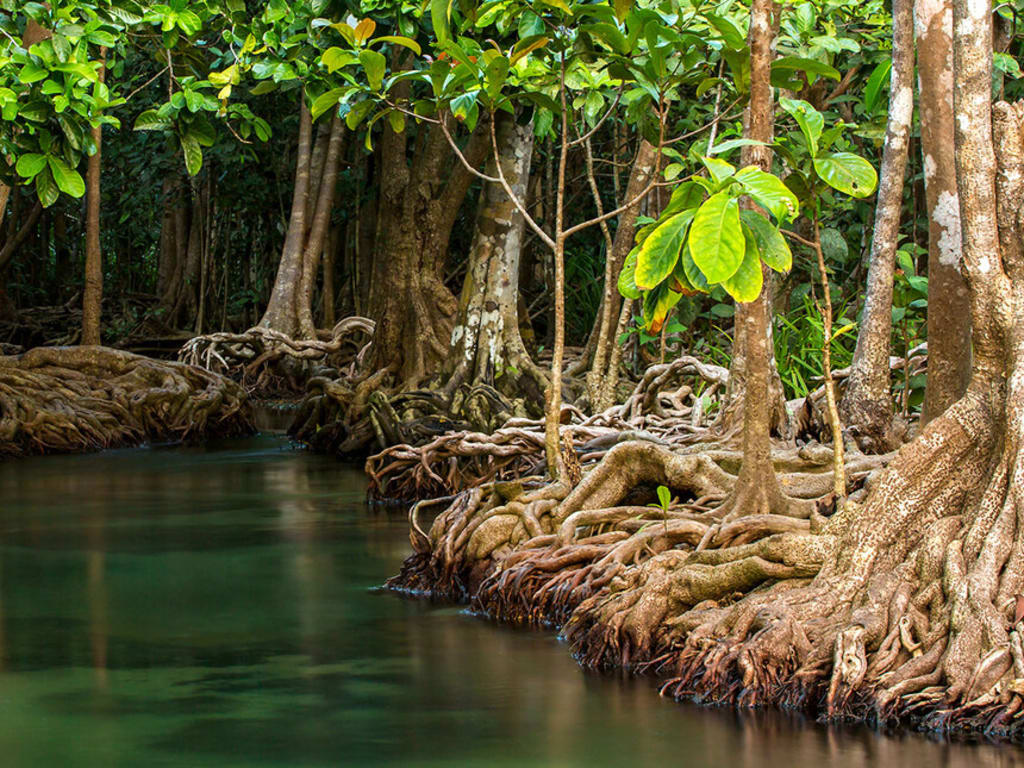Importance of restoration of the mangrove forest ecosystem
Mangrooves

What are Mangroves?
Mangroves are also known as tropical nautical trees, are an aspect of coastal vegetation made up of trees and shrubs (Rhizophora-genus) that thrive in tropical and subtropical intertidal zones. Brackish water is salty, but not as salty as sea water, and mangroves can flourish there thanks to their unique aerial roots and salt-filtering tap roots. More than 100 nations on earth have mangrove forests, mostly in the tropics. Mangrove species are most diverse in the world, with 5747 different species. They provide a variety of perks and are crucial for coastal ecosystems. Mangrove trees come in an assortment of species and can be spotted all over the world. Some species to be very close to a significant fresh water supply (like a river), whereas certain groups prefer greater salinity. Certain individuals like places that are protected from the sea. During times of high tide, the roots of some species are constantly submerged in seawater. Others develop closer to the beach because they are more susceptible to salinity. Although a few perhaps are land-based, they are nonetheless a part of the environment.
Mangrove environments have been utilised for ages for the construction of harbours, agriculture, mining, and human settlements. In the late 1970s and early 1980s, commercial prawn farming was conducted in mangrove areas. Shrimp aquaculture in mangrove environments, however, turned out to be an unsustainable practise. Here are some of the essential traits and roles of mangroves.
Importance of restoration of Mangroves Forest:
Mitigating climate change:
Adaptation to increasing sea levels: The melting of polar ice and the thermal expansion of the oceans are two effects of climate change that are contributing to rising sea levels. By absorbing silt and organic material, mangroves can help lessen the effects of increasing sea levels by gradually elevating the forest floor. The forest can keep up with rising sea levels as the mangrove sediment accumulates vertically, maintaining its protective properties and the corresponding capacity for carbon storage.
Avoidance of carbon emissions: The preservation and regeneration of mangroves also helps to limit the atmospheric release of large volumes of carbon dioxide. When compared to other terrestrial ecosystems, mangrove forests have an amazing capacity to store carbon. The carbon held in mangroves' biomass and sediments is released as CO2 when they are destroyed or damaged, whether for urban expansion, aquaculture, or farming. This increases greenhouse gas emissions and the rate of global warming. Mangrove forest preservation and restoration aid in reducing these carbon emissions.
Coastal protection:
Natural barrier: Mangroves act as a natural barrier against storm surges, which happen during strong storms or hurricanes. Mangrove forests operate as a physical barrier by absorbing and diffusing the energy of storm surges through their dense vegetation. They aid in preventing erosion from currents, tides, and storms by lowering wave energy, preserving the soil, and retaining sediments. Mangroves serve as a first line of defence, stopping land loss and defending priceless coastal infrastructure, including buildings, roads, and agricultural areas. As a result, both human communities and the ecosystems supporting the mangroves are protected by a reduction in the frequency and severity of floods in coastal areas.
Soil stabilization: Mangrove roots capture sediments and organic debris, aiding in the stabilization and building up of the soil. The extensive root structure anchors the soil and prevents soil erosion.
Hotspot for biodiversity:
Biodiversity hotspots: Mangrove forests are among the most biodiverse ecosystems on the globe. They are called biodiversity hotspots. Many of the species found in mangroves are endemic, or unique and cannot be found elsewhere, and they support a great diversity of species. Mangroves serve as interfaces between the land and marine ecosystems, fostering a variety of richly varied species.
Ecological connectivity: Mangroves are essential for maintaining biological connection between various environments. In order to facilitate the movement of creatures and the exchange of nutrients between these habitats, they act as links between terrestrial, marine, and estuarine ecosystems. By encouraging gene flow, nutrient cycling, and the constancy of biological processes, this interconnectedness improves the general wellbeing and adaptability of coastal ecosystems.
Habitat for diverse species: Mangrove forests offer a distinctive and extremely productive habitat for a variety of species. They also serve as important breeding grounds. Numerous marine and terrestrial creatures use them as nurseries, spawning grounds, and feeding grounds. A number of microhabitats, including tidal pools, mudflats, and submerged roots, are created by the intricate root systems, prop roots, and dense vegetation. These microhabitats sustain a range of species that are adapted to these particular conditions.
Fish and shellfish habitat: Mangroves are essential habitats for fish and shellfish, especially species that are valuable commercially. Fish juveniles can grow and mature before going out into open seas thanks to the mangrove forests' enormous root systems and sophisticated network of cover. Additionally, mangroves provide an abundance of food supplies, including debris, algae, and small invertebrates, which support a variety of fish and shellfish species.
Avian diversity: Many different bird species depend on mangroves as their primary nesting and feeding grounds. They offer migrating birds a haven by supplying nesting habitats, roosting spots, and an abundance of food supplies. For coastal and wading bird species that depend on the intertidal zone for feeding on fish, crabs, and other small animals, mangroves are especially important.
Mammal and reptile habitats: Habitats for mammals and reptiles: Mangrove forests are home to a wide range of mammals and reptiles. In and around mangrove environments, you can find animals like mangrove monkeys, otters, manatees, and dolphins. Turtles, such as green turtles and hawksbill turtles, also use mangroves as nesting areas because they need flora and unspoiled sandy beaches for successful nesting and hatching.
Traditional and Medicinal use of Mangroves ecosystem:
Food resources: Mangroves have traditionally served as a source of food for traditional communities. A wide variety of seafood, including fish, crabs, molluscs, and shellfish, can be found in the woodlands. Coastal cultures frequently gather and eat mangrove-associated creatures, such as crabs and oysters, as a source of protein-rich diet.
Tannins and dyes: Mangrove bark contain a high concentration of tannins, which have astringent characteristics. Tannins collected from mangroves have historically been used to tan hides and create textile colours. The tannins are also employed in conventional dyeing techniques to produce a variety of colours. They can be used to preserve and protect animal skins from deterioration.
Honey production: Mangrove ecosystems are the perfect home for honeybees, and traditional societies have long engaged in honey production from these ecosystems. Because of its distinctive flavour and potential health benefits, mangrove honey is highly valued. It is frequently employed in conventional medicine as a treatment for allergies, coughs, and sore throats.
Cultural and spiritual significance: Cultural and spiritual relevance: For many coastal communities, mangroves have both cultural and spiritual value. They are linked to mythology, rituals, and conventional beliefs and are regarded as sacred in some societies. Mangroves are frequently viewed as representations of tenacity, adaptation, and the connection between land and water.
Conclusion:
The restoration of mangroves offers several benefits and applications that contribute to various aspects of human well-being and environmental sustainability. It presents a holistic solution to promote environmental sustainability and enhance the resilience of coastal ecosystems and communities.






Comments
There are no comments for this story
Be the first to respond and start the conversation.